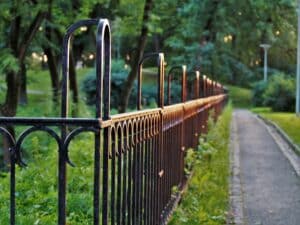TL;DR
Your metal gate might be slowly deteriorating — not from heavy storms or impact, but from everyday sources like sprinklers, irrigation, and soggy soil. This guide walks you through how to identify the damage, prevent it, and save your investment before small issues turn into expensive replacements.
The Death You Didn’t See Coming
Most homeowners expect their metal gate to wear down from big, visible threats — car dents, major rust spots, break-ins. But in reality, many metal gates begin deteriorating from the bottom up, long before you notice any dramatic signs.
The cause? Quiet culprits like sprinkler overspray, moisture-trapping mulch, and poorly drained soil. These factors may seem harmless, but over time they lead to corrosion, warping, and eventually a gate that no longer latches, aligns, or looks the way it should.
And because this type of damage happens slowly, it often goes unnoticed — until it’s too late.
If your property has wrought iron gates, iron and wood gates, or any metal fencing elements near irrigation or damp areas, this post is especially for you.
We’ll break down what causes this kind of “silent death,” how to spot it early, and how to protect your investment before repair becomes replacement.
How Sprinklers and Soil Slowly Kill A Metal Gate
At first glance, a sprinkler head facing the edge of your driveway might not seem like a big deal. But over months (and years), repeated exposure to water creates localized corrosion — especially at weld joints and hinge points, which are already vulnerable.
The Three Most Common Causes of Hidden Gate Damage:
| Source | How It Harms Your Gate | What It Looks Like Over Time |
|---|---|---|
| Sprinkler Overspray | Constant water exposure at the base | Peeling paint, early rust rings near feet |
| Poor Drainage/Soil | Moisture held in soil keeps gate posts wet | Gate leaning, base corrosion |
| Mulch and Organic Buildup | Organic material holds moisture at contact point | Wood-rot if mixed, bubbling paint |
Most powder-coated or painted metal gates are designed to withstand rain. What they aren’t designed for is daily localized exposure to moisture at the base, where the protective finish can weaken.
Soil-related issues are even sneakier: if your gate post is seated in wet soil or improperly set concrete, it will start rusting internally before you ever see a problem.
According to the American Galvanizers Association, even galvanized steel can begin to rust if it sits in damp environments with poor airflow for extended periods/
Signs It’s Already Happening (And Most People Miss Them)
Corrosion and warping don’t announce themselves overnight. They creep in through small, avoidable oversights. If you catch the damage early, you can prevent most long-term costs with simple fixes.
Here’s what to watch for:
Early Signs of Moisture Damage in A Metal Gate
-
Bubbling paint near the base of the gate or post
-
Tiny rust freckles around welds or hinge brackets
-
Gate no longer swings evenly or drags slightly
-
Faint leaning of vertical support posts, especially after rain
-
Chipping or flaking around joints, even if paint looks fine elsewhere
These issues might seem cosmetic at first. But bubbling paint is one of the earliest signs that water has penetrated your gate’s protective finish — and the corrosion has already begun underneath.
Once rust forms inside a hollow post or around a concealed hinge, it’s very difficult (and costly) to reverse.
This kind of progressive damage is particularly common in older metal gates and hybrid builds like iron and wood gates, where wood can absorb and hold moisture close to the metal frame.
If you’re unsure whether the signs you’re seeing are cosmetic or serious, take a look at this Irish Iron blog about comparing steel vs wrought iron. It breaks down how different materials age and what early-stage damage looks like depending on build type.
How to Protect Your Gate (Without Replacing It)
The good news: you don’t need to replace your entire gate system to stop this kind of decay. Small design adjustments and routine maintenance are usually enough to extend the life of your gate by years — and protect your curb appeal in the process.
Here’s what we recommend:
Prevention Checklist for Moisture-Related Gate Damage
| Step | Why It Matters |
|---|---|
| Redirect sprinkler heads | Keeps water from hitting gate posts directly |
| Clear mulch or soil away | Prevents base moisture buildup at contact points |
| Repaint or reseal base areas | Adds a fresh moisture barrier around vulnerable zones |
| Check concrete footings | Makes sure posts aren’t soaking up water from loose soil |
| Clean and dry gate monthly | Removes debris that traps moisture |
A quick monthly visual inspection can help you spot bubbling paint, loose hinges, or discolored patches early — before repairs get expensive.
And if you’re installing a new gate, be sure the posts are set with proper drainage in mind. Avoid enclosing the base in mulch or setting the concrete flush with the soil. Leave just a small clearance, and you’ll dramatically improve ventilation.
For homeowners in damp or sprinkler-heavy areas like Northern California, we sometimes recommend switching to aluminum or powder-coated steel depending on your climate and style preferences. Each material has trade-offs — and that’s something our team is happy to walk you through during an on-site quote.
FAQs: Real Questions Homeowners Ask About Gate Damage
Q: Can I just repaint the rust spots and be done with it?
A: Painting over rust without sanding or treating it first will only mask the issue temporarily. You need to fully remove the corrosion, prime the surface with rust-inhibiting products, then repaint.
Q: Is it safe to install sprinklers near my fence or gate?
A: Only if you carefully angle the heads away and ensure proper drainage. Ideally, no spray should hit metal surfaces directly.
Q: What about automatic gates? Does moisture affect the motor?
A: Yes. Excess moisture near the base can lead to wiring issues or corrosion in lower-housed motor systems. Automatic driveway gates should be installed with sealed components and clear runoff paths.
Why It Pays to Act Now (Before It Gets Expensive)
Gate damage doesn’t just hurt your home’s appearance—it can directly impact functionality, security, and resale value. A minor issue like bubbling paint might seem cosmetic, but if it leads to internal rusting or post shifting, repairs can easily spiral into full replacements.
Let’s break it down:
Estimated Costs (Fix Now vs. Wait Too Long)
| Issue | Early Fix Cost | Delayed Repair Cost |
|---|---|---|
| Repainting bubbled areas | $150–$300 | $1,200+ full refinishing |
| Post re-stabilization | $200–$500 | $1,500+ for new posts and concrete |
| Rusted hinge replacement | $100–$250 | $800+ for re-welding + refinishing |
| Automatic gate motor damage | $250–$600 | $2,000+ full motor/electrical replacement |
Proactive care saves thousands—and it protects your investment long-term. Especially if you plan to sell your home or already have other exterior upgrades in place, your gate should reflect the same level of upkeep.
And remember, buyers notice these things. An aligned, rust-free, secure gate is a signal of overall maintenance. A deteriorating one is a silent red flag.
Final Thoughts: Keep the Gate, Stop the Damage
You don’t have to wait for visible rust or structural failure to start protecting your metal gate. Most damage starts subtly—with water, with soil, with one sprinkler too close to the post.
But the good news? It’s almost always preventable.
At Irish Iron, we’ve helped hundreds of homeowners identify small issues before they became big ones. Whether you’re dealing with surface rust, sinking posts, or a gate that’s just not looking as sharp as it used to, we can help.
Contact Irish Iron today for a no-pressure assessment. One quick walkthrough could save you thousands—and preserve the look, function, and value of your gate for years to come.



